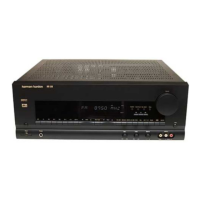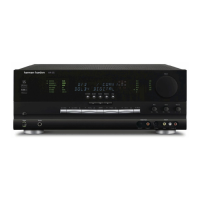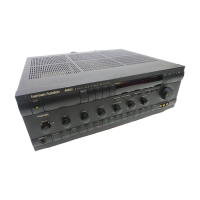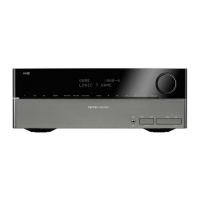28 OPERATION
Operation
Surround Mode Chart
MODE FEATURES DELAY TIME RANGE
DOLBY DIGITAL Available only with digital input sources encoded with Dolby Digital data. It provides Center: 0 ms – 5 ms
up to five separate main audio channels and a special dedicated Low Frequency Effects Initial Setting – 0 ms
channel. Surround: 0 ms –15 ms
Initial Setting – 0 ms
DTS Available only with digital input sources encoded with DTS data.Available on special Delay time not adjustable
DVD, LD and audio-only discs, DTS provides up to five separate main audio channels and
a special dedicated low frequency channel.
DOLBY PRO LOGIC The standard mode for analog surround sound decoding. It uses information encoded 15 ms – 30 ms
in a two channel stereo recording to produce four distinct outputs: Left, Center, Right and Initial Setting = 15 ms
a Mono Surround channel. Use this mode for accurate reproduction of programs bearing
the Dolby Surround, DTS Stereo, UltraStereo or other “Surround” logos. Surround-encoded
programs include videocassette, DVD and LD movies, TV and cable programs, radio
programs and audio CDs. Dolby Pro Logic processing may also be used to provide a
pleasing surround effect with some stereophonic source material that does not carry
surround encoding.
DOLBY 3 STEREO Uses the information contained in a surround encoded or two channel stereo program to No surround channels
create center channel information. In addition, the information that is normally sent to the
rear channel surround speakers is carefully mixed in with the front left and front right
channels for increased realism. Use this mode when you have a center channel speaker
but no surround speakers.
THEATER This surround processing uses matrix surround decoding to simulate a standard movie or Delay time not adjustable
stage theater with stereo and even pure mono sources.
HALL 1 and HALL 2 The two Hall modes offer matrix surround decoding choices that simulate Delay time not adjustable
a medium-sized chamber hall or opera house with stereo and even pure mono sources.
VMAx Near When only the two front channel loudspeakers are used, Harman’s patented VMAx mode No surround channels
VMAx Far delivers a three-dimensional sound space with the illusion of “phantom speakers” at the
center and surround positions. The VMAx N, or “Near Field” mode should be selected when
your listening position is less than 1,5m from the speakers.The VMAx F, or “Far Field” mode
should be selected when your listening positioin is greater than 1,5m from the speakers.
5-Channel Stereo This mode takes advantage of multiple speakers to place a stereo signal at both the front and No delay is available for
back of a room. Ideal for playing music in situations such as a party, it places the same signal this mode
at the front-left and surround-left, and at the front-right and surround-right speakers.The center
channel is fed a summed mono mix of the in-phase material of the left and right channels.
SURROUND This mode turns off all surround processing and presents the pure left and right No surround channels
OFF (STEREO) channel presentation of two channel stereo programs.
LOGIC 7 C
LOGIC 7 M
An advanced mode that extracts the maximum surround information from either
conventional stereo material or surround-encoded programs. When used with encoded
material, decoding is more accurate in terms of the placement of sounds, and fades and pans
are much smoother and more realistic than with other decoding techniques. Logic 7 also
delivers increased spaciousness and a wider sound stage when it is used with conventional
natural stereo recordings and music programs throug the use of the natural surround
information present also in those stereo recordings. The Logic 7C or Cinema mode is tailored
to provide an optimal sound field for movie soundtracks. The Logic 7M or Music mode uses a
decoding formula that is best suited to music.
Delay time not adjustable
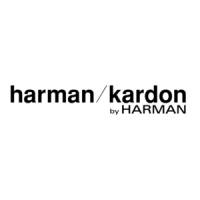
